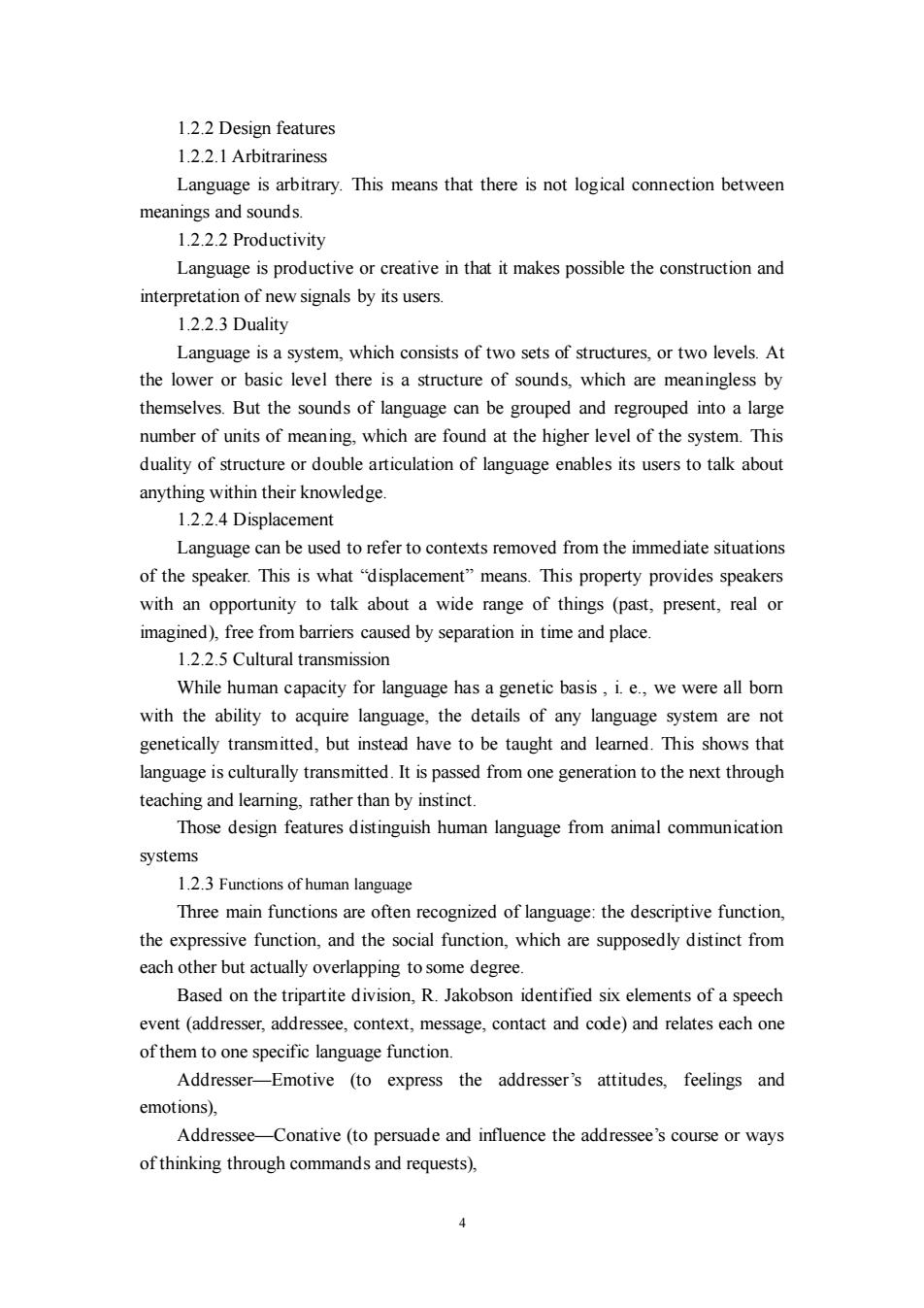正在加载图片...

1.2.2 Design features 12 2 1 Arbitrariness Language is arbitrary.This means that there is not logical connection between meanings and sounds. 1.2.2.2 Productivity Language is productive or creative in that it makes possible the construction and interpretation of new signals by its users 1.2.2.3 Duality Language is a system,which consists of two sets of structures,or two levels.At the lower or basic level there is a structure of sounds,which are meaningless by themselves.But the sounds of language can be grouped and regrouped into a large number of units of meaning.which are found at the higher level of the system.This duality of structure or double articulation of language enables its users to talk about anything within their knowledge. 1.2.2.4 Displacement Language can be used to refer to contexts removed from the immediate situations of the speaker.This is what "displacement"means.This property provides speakers with an opportunity to talk about a wide range of things (past,present,real or imagined),free from barriers caused by separation in time and place 1.2.2.5 Cultural transmission While human capacity for language has a genetic basis,i.e.,we were all born with the ability to acquire language.the details of any language system are not genetically transmitted,but instead have to be taught and leamed.This shows that language is culturally transmitted.It is passed from one generation to the next through teaching and leaming.rather than by instinct. Those design features distinguish human language from animal communication systems 12.3 Functions of human language Three main functions are often recognized of language:the descriptive function, the expressive function,and the social function,which are supposedly distinct from each other but actually overlapping to some degree. Based on the tripartite division,R.Jakobson identified six elements of a speech event(addresser,addressee,context,message,contact and code)and relates each one ofthem to one specific language function. Addresser-Emotive (to express the addresser's attitudes,feelings and emotions). Addressee-Conative(to persuade and influence the addressee's course or ways of thinking through commands and requests), 4 1.2.2 Design features 1.2.2.1 Arbitrariness Language is arbitrary. This means that there is not logical connection between meanings and sounds. 1.2.2.2 Productivity Language is productive or creative in that it makes possible the construction and interpretation of new signals by its users. 1.2.2.3 Duality Language is a system, which consists of two sets of structures, or two levels. At the lower or basic level there is a structure of sounds, which are meaningless by themselves. But the sounds of language can be grouped and regrouped into a large number of units of meaning, which are found at the higher level of the system. This duality of structure or double articulation of language enables its users to talk about anything within their knowledge. 1.2.2.4 Displacement Language can be used to refer to contexts removed from the immediate situations of the speaker. This is what “displacement” means. This property provides speakers with an opportunity to talk about a wide range of things (past, present, real or imagined), free from barriers caused by separation in time and place. 1.2.2.5 Cultural transmission While human capacity for language has a genetic basis , i. e., we were all born with the ability to acquire language, the details of any language system are not genetically transmitted, but instead have to be taught and learned. This shows that language is culturally transmitted. It is passed from one generation to the next through teaching and learning, rather than by instinct. Those design features distinguish human language from animal communication systems 1.2.3 Functions of human language Three main functions are often recognized of language: the descriptive function, the expressive function, and the social function, which are supposedly distinct from each other but actually overlapping to some degree. Based on the tripartite division, R. Jakobson identified six elements of a speech event (addresser, addressee, context, message, contact and code) and relates each one of them to one specific language function. Addresser—Emotive (to express the addresser’s attitudes, feelings and emotions), Addressee—Conative (to persuade and influence the addressee’s course or ways of thinking through commands and requests)